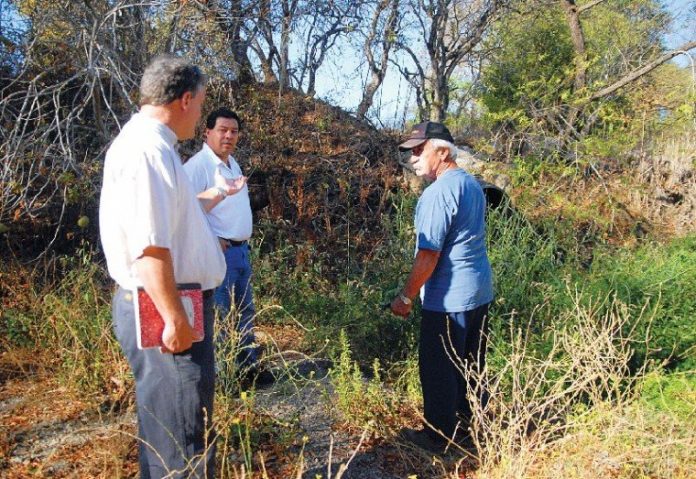There are so many small-scale agricultural operations in and
around Gilroy that state officials charged with safeguarding water
ways such as Uvas Creek against pesticide and waste-water pollution
are having trouble keeping track of them.
Gilroy – There are so many small-scale agricultural operations in and around Gilroy that state officials charged with safeguarding water ways such as Uvas Creek against pesticide and waste-water pollution are having trouble keeping track of them.
On a Tuesday morning field trip to various “discharge spots” along the Uvas Creek near Hecker Pass Highway, just west of the city, Central Coast Regional Water Quality Control Board Engineer Mike Higgins and California Department of Fish and Game Biologist Michelle Leicester followed environmentalist Herman Garcia around because he’s discovered multiple suspicious pipes that channel tainted water into the dry creek bed.
Leicester expressed particular concern over a make-shift dam north of four discharge points the crew inspected. By diverting water released from the Uvas Creek dam away from its natural path, the questionable dam has desiccated fish breeding grounds farther downstream, leaving the discharges as the only visible moisture.
A nearby resident said the dammed water’s been sudsy for the past six weeks, and Leicester said the dam’s most likely illegal (regardless of the alleged suds) unless the unknown dam-builder has a so-called “1600 permit” to alter a stream bed used by endangered species. Leicester was waiting to hear back from fish and game staff on the status of the permit Tuesday afternoon, and even though Higgins didn’t take any samples, both said they’d follow up on the sites. Results of the permit status inquiry were not available by press time.
The restricted water flow has harmed the endangered steelhead trout that use Uvas Creek as spawning grounds before returning to the sea, Garcia said. The drought has exacerbated this by evaporating many of the trout’s waterways, leaving some stranded in isolated pools, from which Garcia tries to rescue them.
Christopher Ranch drew attention to their existence in February after potent garlic-tainted water spilled into the creek and poisoned several steelhead.
Adding to the situation along Uvas Creek, though, are growers who regularly discharge potentially harmful water into the dry beds, Garcia said. Some have permits to do so under the water board’s “faith-based ag waiver program,” but about 500 sites aren’t enrolled in the program and may or may not be funneling their used water into waterways such as Uvas Creek, according to Elaine Sahl, an environmental scientist with the water quality control board who said the program relies on its enrollees’ diligence. Hence “faith-based.”
“Essentially the idea is that they’re making progress toward improving their discharges,” Higgins said Tuesday morning as he inspected a black plastic corrugated pipe jutting out through the creek bank from the Bonfante Tree Nursery at 3675 Hecker Pass Highway. Next door to the site, at 3875 Hecker Pass Highway, is the Westside Nursery, which Sahl confirmed has not enrolled in the program, making it one of the 500 unregistered sites. Higgins didn’t visit the site to see if it was actually discharging, but Sahl said they’re trying to enroll the nursery.
Both Sahl and Higgins described the program as a mixture of mandates and honor.
All dischargers must enroll in the water board’s ag waiver program and then attend educational seminars before compiling a pollution-reduction plan that must materialize, Higgins said, lest one of the water board’s six Ag Waiver inspectors happens to pop in for a visit.
But these visits are rare since the six inspectors and their two interns cover seven counties along the Central Coast. Inspections began about two months ago, Sahl said, and 15 have been completed. But there are about 2,000 registered sites to inspect, and another 500 that remain unregistered, she said. This means that each inspector oversees more than 400 sites.
The water board knows about the 500 unregistered sites because it corresponds with agricultural commissioners to see who’s using pesticide and where, Sahl said. She and her inspectors then cross-reference this information with their database, which she said is being updated now.
Despite the daunting task, Sahl said, “We are always going out into the field, and we are actively pursuing enforcement of people who aren’t enrolled in the program.”
The waiver program stems from the national Clean Water Act of 1977, which created the National Pollutant Discharge Elimination System to protect all of the country’s waterways. The water quality board enforces this law.
While large-scale sites like Christopher Ranch have stricter discharge permits and receive more regular inspections, smaller-scale sites like Bonfante’s seven-acre tree nursery – which Higgins said probably uses fertilizers and pesticides – can’t receive the same attention.
“It’s infeasible to capture irrigation water [from smaller sites] because it would be like the space program,” he said. “So we came up with the Ag Waiver program instead.”
A representative from the Bonfante nursery did not return a message for comment by press time Tuesday.
The two-year-old Ag Waiver program allows discharge as long as the site’s follow requirements “to do good faith efforts toward decreasing its amount of pollution,” Sahl said.
The honor-system-like program relies on people such as Garcia, president of the nonprofit Coastal Habitat Education and Environmental Restoration.
“That’s why I’m interested in coming out here, because you guys are discovering all of these issues,” Higgins told Garcia and Raul Rivas, another CHEER volunteer, as the men inspected a suspicious pipe off Hecker Pass Highway.
“Well, it’s up to you to determine what’s going on,” Garcia replied.














